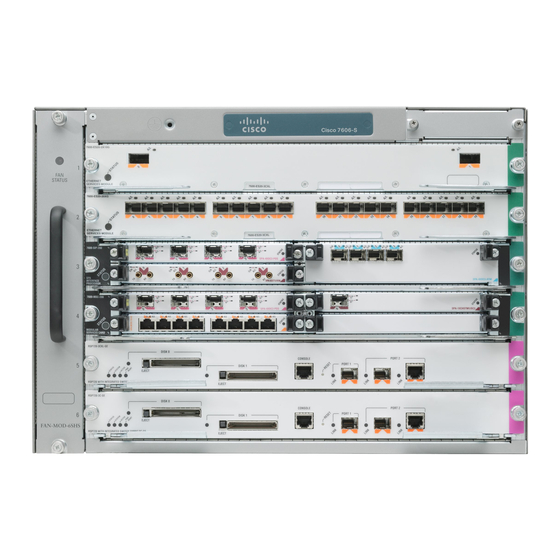Cisco 7606 Brosur - Halaman 7
Jelajahi secara online atau unduh pdf Brosur untuk Perangkat Keras Jaringan Cisco 7606. Cisco 7606 8 halaman. User guide
Juga untuk Cisco 7606: Panduan Pengguna (28 halaman)

Channelized
• 1-port OC-12c/STM-4c (DS3) with 4 ports of Gigabit Ethernet
• 1-port OC-48c/STM-16c (DS3) with 4 ports of Gigabit Ethernet
Dynamic Packet Transport
• 2-port OC48/STM-16 POS/DPT with 4 ports of Gigabit Ethernet
As shown above, each of the POS, ATM, and Channelized OSMs provides an additional four ports of Gigabit
Ethernet to complement the WAN ports on each line card. These Gigabit Ethernet ports are not PXF enabled, so they
do not have the advantage of the high-touch IP network services provided by PXF. They do, however, provide basic
packet buffering and QoS mechanisms, as well as Cisco Gigabit EtherChannel
four ports on the Gigabit Ethernet WAN OSM are all PXF enabled and they are used to provide Layer 3 connectivity
and services in the WAN and MAN areas.
Investment Protection
In addition to OSMs, the Cisco 7600 incorporates the FlexWAN module. The FlexWAN module enables the Cisco
7600 to use most of the port adapters shared with the Cisco 7200 and 7500, thus providing great investment
protection in Cisco interfaces. FlexWAN allows the Cisco 7600 to aggregate low-speed traffic from n x DS0 to OC-3,
thus complementing the high-speed interfaces offered by OSMs.
In addition, the Cisco 7600 supports the traditional LAN cards of the Catalyst 6500, including 8- and 16-port
Gigabit Ethernet, 48-port 10/100BASE-TX, 24-port 100BASE-FX, 24-port 10BASE-FL cards and 1 port 10 Gigabit
Ethernet.
Intelligent IP Services
Cisco 7600 IP services can be classified into four categories as follows:
• PFC2-Based IP Services
• PXF-Based Services
• BGP Policy Accounting System
• Multi protocol Label Switching
PFC2-Based IP Services
Several services are centralized in the PFC2; they run at 30 Mpps, including ACL, classification, and marking based
on differentiated services code point (DSCP), type of service (ToS) and interface (physical or logical), and
policy-based routing (PBR).
PXF-Based Services
The PXF processing complex provides high-performance QoS features on the OSMs. PXF was developed to provide
efficient queue-scheduling that integrates traffic shaping with hierarchical link sharing while supporting a large
number of queues while sustaining high performance.
PXF implements a separate queue for each DSCP value or interface (either logical or physical). This queuing
mechanism offers OSMs the ability to provide very granular hierarchical traffic shaping and link sharing for up to
16000 (8000 per PXF) simultaneous queues per OSM and 66 queues per logical interface.
All contents are Copyright © 1992–2002 Cisco Systems, Inc. All rights reserved. Important Notices and Privacy Statement.
Cisco Systems, Inc.
Page 7 of 8
®
technology. On the other end, the
